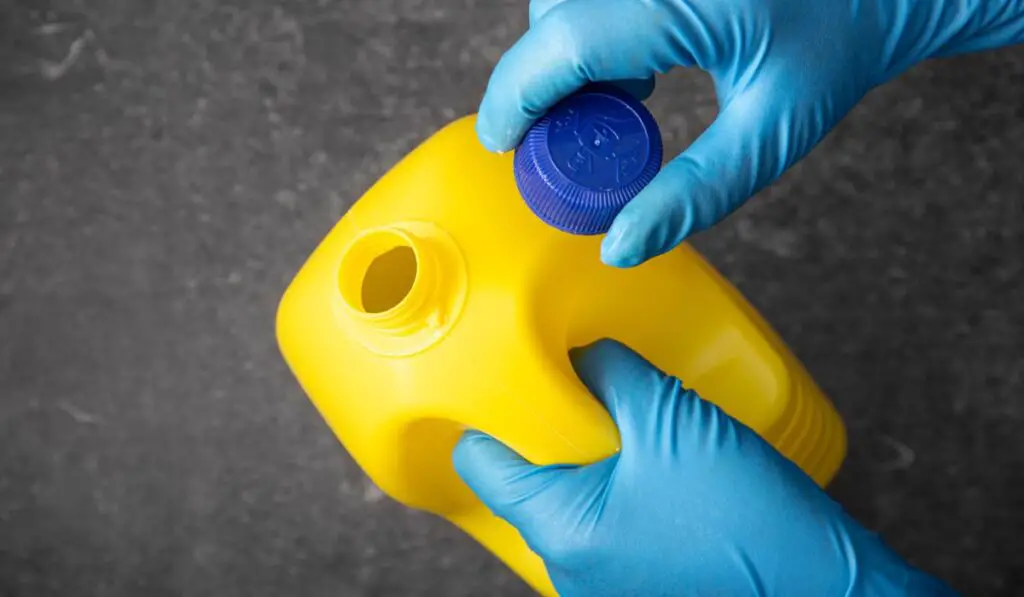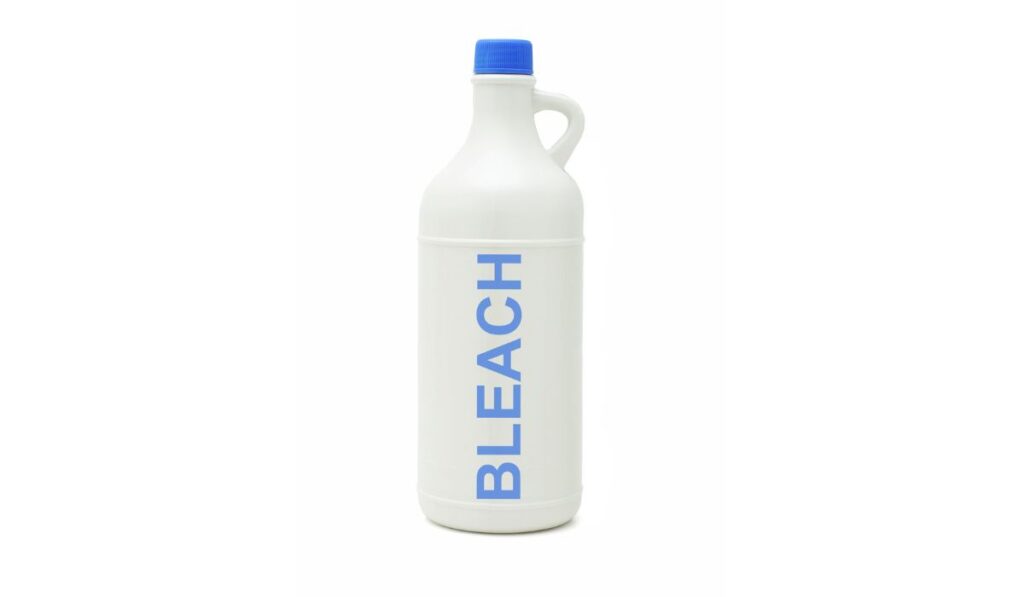If your pool has algae and bacteria, you’ll have to pour chlorine or bleach to sanitize it. While most people use chlorine as a pool sanitizer, you can also use pool bleach. But what about using regular bleach to sanitize your pool? Is it a good option?
Bleach is mixture of liquid chlorine and water, but not all mixtures of liquid chlorine and water are bleach. In the US, bleach is 5-6% chlorine. A more concentrated liquid chlorine solution (50-60%) is better for long term treatment of a pool, to avoiding needing lots of gallons of bleach.
So, should you switch to regular bleach instead of pool chlorine to maintain the water’s pH and sanitize the pool? Let’s explore the benefits of bleach and chlorine, what makes them different, and whether you can use bleach in your pool.
Chlorine vs. Bleach: What’s the Difference?

Both normal household bleach (example on Amazon) and more concentrated chlorine additives have similar chemical compositions, but bleach is essentially a diluted version of concentrated liquid chlorine. Bleach may also have additives, depending on what it was meant to be used for.
Chlorine is typically used to clean pools and industrial cleaning, while bleach can be used as a household cleaner. Both are designed to kill bacteria and other microorganisms and can be used as sanitizers.
Let’s look at the differences between the two so you have a better idea of which to use in your pool:
Chlorine Concentration
Bleach contains far less concentration of chlorine per gallon than the liquid chlorine made to sanitize your pool:
- Regular bleach contains 5-6% of chlorine
- Liquid chlorine is available with 65% to 100% chlorine.
This means you will need to use more bleach in your pool than you will use liquid chlorine. This is because people vastly prefer a sanitizing agent with a higher percentage of chlorine concentration as they’ll need to use less.
Also, a lower chlorine concentration means that adding bleach may not have the same sanitizing effect in your pool as liquid chlorine.
Color and Fragrance
Bleach, like chlorine, has an unwanted color and fragrance, which can spoil your pool experience. You’ll probably not want your pool to smell like a summer breeze, so odorless liquid choline is a better option.
Shelf Period
Liquid chlorine has less shelf period than bleach. So, if you’re planning on storing your pool cleaning chemicals for longer, you’re better off buying more bleach and less chlorine. Nevertheless, lower shelf life means chlorine is more active and effective.
pH Level
Bleach has a lower pH level than liquid chlorine. Bleach contains a 12.5 pH level, while liquid chlorine goes up to 13%. This makes it more dangerous to use bleach in already slightly acidic or neutral pools, as it may upset the pool’s pHI balance.
Cost Efficiency
When it comes to cost, bleach is cheaper than liquid chlorine. However, since you have to use more bleach to sanitize your pool than chlorine, you’ll end up paying less for liquid chlorine.
Are There Benefits to Using Regular Bleach Over Chlorine?
While it’s not recommended, some people prefer regular bleach over liquid chlorine due to its cost efficiency, higher shelf life, and availability.
Let’s look at these benefits in detail:
Bleach is Cheaper
Regular bleach costs a bit less than liquid chlorine.
Many pool owners who are price-conscious may opt for bleach because of this. In some cases, regular bleach can cost almost half as much as liquid or pool chlorine, so you’ll save more in the short term.
Bleach Has a Longer Shelf Life
Since bleach has a longer shelf life than liquid chlorine, it’s much better to buy it in bulk.
Regular bleach can be stored for up to 6 weeks, whereas liquid chlorine usually only lasts a week or two. Therefore, regular bleach may be a more attractive option if you like to buy pool cleaning chemicals in bulk.
Bleach is Easily Available
If you decide to use regular bleach over chlorine, you won’t need to shop at a specific pool-supply store, as you can buy regular bleach at most superstores. However, the availability of chlorine differs in various areas.
You Don’t Need to Mix the Bleach
You won’t need to mix the bleach before adding it to your pool. However, chlorine needs to be mixed properly and may cause splashes and burns if not added to the pool correctly.
So, essentially, bleach is slightly safer than chlorine.
Disadvantages of Regular Bleach
While using regular bleach has some benefits, like cost efficiency and higher shelf life, you also need to consider its disadvantages before using it in your pool.
Disadvantages of using regular bleach in your pool include:
- Bleach has no stabilizer to support it and can break down when exposed to sunlight.
- Bleach can splash the water while you pour it.
- Bleach chlorine, like any other form of chlorine, can stain the pool liner.
Always read the label on the bleach bottle carefully before buying since it tells you about the percentage of chlorine, flavoring and coloring agents, and other chemicals you need to know before using it.
Buying the Right Kind of Bleach

If you unknowingly buy the wrong kind of bleach, it can damage your pool.
The two most commonly used bleaches are chlorine bleach and oxygen bleach. Both can be used in your pool, but you’ll have to take different precautions for each.
Oxygen Bleach
Oxygen bleach is non-chlorinated bleach. It’s less toxic, more environmentally friendly, and recommended to use on washable garments, especially if you have sensitive skin.
To use oxygen bleach, you need to have warm or hot water. Pour the oxygen bleach into the water and mix it properly before adding the clothes. Then, add the clothes and dip them completely into the water. The bleach should help remove stains.
Oxygen bleach is available in powder and liquid forms, but the powder form is more effective. However, it’s not ideal for cleaning your pool water.
Chlorine Bleach
If you want to use regular bleach to sanitize your pool, chlorine bleach is the best option. This is because it contains a higher chlorine concentration. The higher the chlorine concentration, the more effective the bleach is.
Before opting for chlorine bleach, make sure you buy a bottle with no fragrance, color, or other chemicals that could spoil your pool water. Also, since it contains less chlorine than liquid chlorine, you need to mix it properly into the water to get it to the desired chlorine level.
Chlorine bleach has no stabilizer; you need to add it to the pool at night so it doesn’t break down quickly. The ideal level for chlorine bleach is 1-3 parts per million (ppm); you’ll need to add bleach daily to kill the microorganisms.
If you want to add regular bleach instead of liquid chlorine, you’ll have to add stabilizers to prevent the bleach from breaking down.
How to Use Stabilizers
Stabilizers are chemicals that help chlorine stay in the water for longer. The most commonly used stabilizer chemical is cyanuric acid, which is essential when balancing your pool’s water.
Chlorine is susceptible to breaking down quickly when exposed to sunlight. Adding stabilizers prevents the chlorine from breaking down and improves its sanitization effect.
However, avoid overusing stabilizers as they don’t break down very well when constantly. In this condition, the additional chlorine you’ll add will immediately be stabilized and unable to kill algae and other waterborne germs.
As a result, the microbes will continue to grow, and eventually, you will see your pool become cloudy and unhygienic.
Most professionals recommend using 30 ppm of stabilizers to keep the chlorine in your pool effective enough to kill germs and other waterborne microorganisms.
Here’s how to correctly add stabilizers to your pool:
- Fill the pool with warm or hot water, as it’s less effective in cold water
- Wear gloves and goggles to protect your skin and eyes.
- Next, add the stabilizer to the pool. Again, make sure to add the right amount. The recommended general rule is to add 13 ounces of cyanuric acid in 10,000 gallons of water to get 10 ppm.
- Run the pool pump for at least an hour after adding the stabilizer so the water can mix properly.
- Use a test kit to maintain the proper concentration of water and stabilizer levels.
- You’ll need to dilute the pool water if the stabilizer level is too high. Then, use any vacuum or filter to drain some of the water out of the pool, and then refill your pool with fresh water.
Adding Treatments the Right Way

If you don’t want to spoil your pool, you’ll need to add pool treatments carefully. If added incorrectly, algaecides and other anti-microorganisms will likely grow.
Always ensure the pool doesn’t contain additional chemicals or additives before adding chlorine, bleach, or stabilizers.
And most importantly, read the instructions before using any chlorinated chemicals and stabilizers to ensure that you’re adding them to the correct concentration.
If you aren’t sure which chemicals to add or how much of a certain chemical to use, consult a professional or ask someone with experience in maintaining pools.
Should You Hire a Professional?
If your pool isn’t too stained or algal growth is in its initial stages, you don’t need to worry, as you can sanitize it yourself. You can use either regular bleach or liquid chlorine to sanitize your pool.
While doing it on your own, you’ll need to do some home testing. For this, you will need standard DPD test kits. However, if this is your first time maintaining the pool water or your pool is in awful condition, you should call a professional to sanitize it.
Also, call a professional if:
- You don’t have the right kit and protective equipment.
- You don’t know how much chemical to add.
- You don’t want to risk damaging your skin with pool chemicals.
